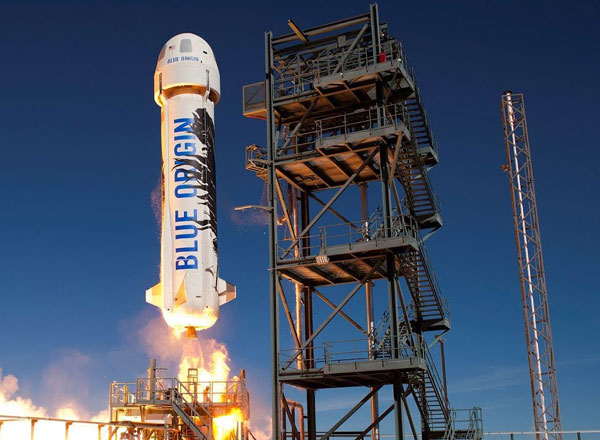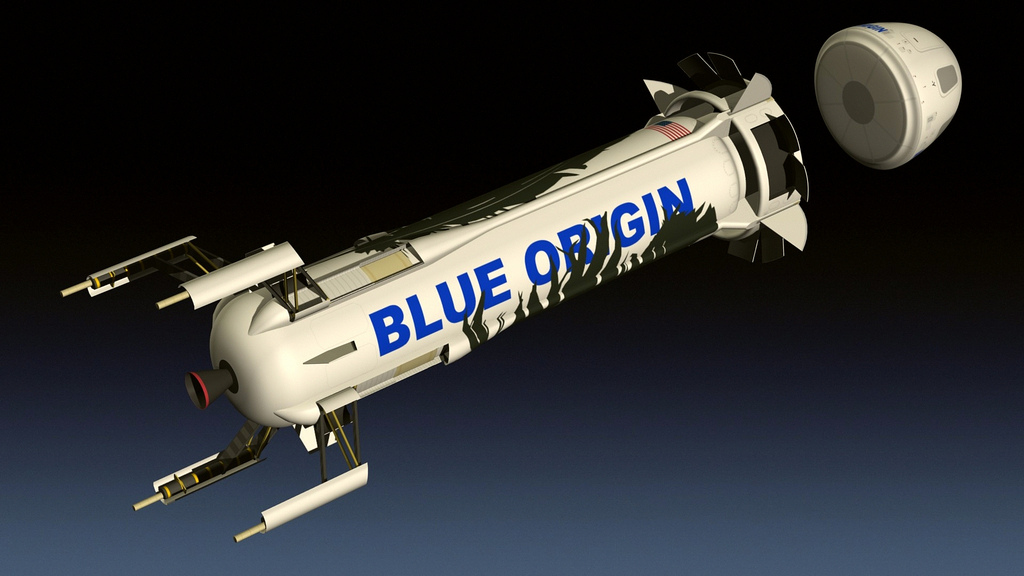Blue Origin – New Shepard
Blue Origin CEO Jeff Bezos has made his fortune from his worldwide online supermarket Amazon. This global phenomenon continues to turnover billions of dollars every year, far more than the economies of many a medium sized country.
All this money means that there is plenty left over to invest in the true love of his life – his Blue Origin space technology company. With grandiose plans to put a human colony on the Moon and send humans to Mars, he’ll need it.
But for us, his most important and practical project in the short term is his plan to carry commercial passengers into space. This is well on the way to reality: the rocket and crew capsule has been designed and is already operating. With an additional booster stage, the rocket is capable of sending satellites into orbit and could potentially ferry supplies and equipment to the International Space Station (ISS).
This rocket is called New Shepard, and it is undergoing final testing before being used to carry people into space in the very near future. The plan is to use this rocket and capsule combination to carry fare paying commercial passengers, hopefully becoming the first private company to achieve this feat.
So what exactly are the capabilities of this New Shepard rocket, and what will it be like to travel into space on board its passenger carrying capsule?

New Shepard Rocket
his sleek looking rocket is named after the pioneering US astronaut Alan Shepard – the first American in space. He was launched into space as part of the Mercury programme, reaching a peak altitude of over one hundred miles on May 5th 1961.
Indeed, as far as future commercial passengers are concerned, New Sheppard is a most appropriate name for this rocket. This is because the type of space flight likely to be on offer is very similar to the flight taken by the very first astronaut. Like the original Shepard journey, Blue Origin’s proposed commercial flights will last around 15 minutes from launch to landing, offering potential passengers a few brief minutes to experience weightlessness, the blackness of space and view the curvature of the earth before landing a few hundred miles away in the West Texas desert.
The actual New Sheppard rocket is around 60 feet tall, small by orbital rocket standards. The power is provided by a single rocket motor called the BE-3PM. The engine uses liquid oxygen and liquid hydrogen as fuel, providing over 110,000 lb force of thrust (over a million horsepower). This capability will power it skyward, reaching speeds of over three times the speed of sound (Mach 3). The capsule and its passengers will experience forces of over three times the force of gravity (3G) before reaching the Karman line, set at an altitude of 100km. This is an internationally recognised boundary of space. Achieving this height qualifies people to be officially described as astronauts.
The capsule itself sits on top of the rocket. It has six seats, and 530 cubic feet to move around in. This means that it is a lot more comfortable than the cramped, instrument filled conditions that the intrepid Alan Shepard endured back in 1961. As Jeff Bezos himself boasts, “every seat’s a window seat” on New Shepard, with six large windows constructed with tough composite material, made to withstand the pressure differences involved in space travel. This transparent material is able to let through 92% of visible light, so it’s as good as glass – offering passengers an excellent view during the flight.
The powered phase of the flight lasts for around two and a half minutes, and adventurous pioneer space tourists will need to stay strapped in their seats until this is completed. At this point, the capsule separates from the rocket and coasts on into space. During this phase, near weightlessness will be experienced and passengers will be able to unbuckle and float free in the micro gravity of space. The rocket section of the spacecraft will then return to Earth, on a special pad in the desert.
Meanwhile, the capsule will return to Earth by parachute, landing its human cargo gently in the West Texas desert a few hundred miles away from its original launch.
Testing the New Shepard
The New Shepard rocket has already undergone considerable testing, so it is very close to being used to carry humans for the first time. The footage of the rockets landing within a few feet of their target in the desert ready for re-use is spectacular, and the rockets have already been used to carry experiments and equipment into space for NASA.
The capsule escape system, designed to power the craft away from the rocket if required in an emergency, was successfully tested in 1916, and several more times since. Unlike the iconic Apollo missions, which had an escape tower set on top of the capsule to pull the craft away, New Shepard’s capsule has an internal motor which pushes its passengers to safety with a brief burst of rocket power.
When can we expect to see the first commercial flights?
Judging by recent publicity, CEO Jeff Bezos has his eyes on more distant missions. His “Going to Space to Benefit Earth” press event in May 2019 was full of details of his proposed Blue Moon lunar lander. It was also presented impressive visions of busy lunar colonies, futuristic space stations and proposed trips to Mars too.
He’s going to have to pay for it all somehow though. Even his Amazon retail empire may struggle to cover the costs. A successful commercial space tourism business could go a long way to providing him with the resources necessary to make his vision a reality.
So whilst the spotlight may have been temporarily directed elsewhere, expect Mr Bezos to return to focusing on his sub-orbital space flight business soon. Expect a test flight with humans on board very soon, with the first fare paying passengers following shortly after.

